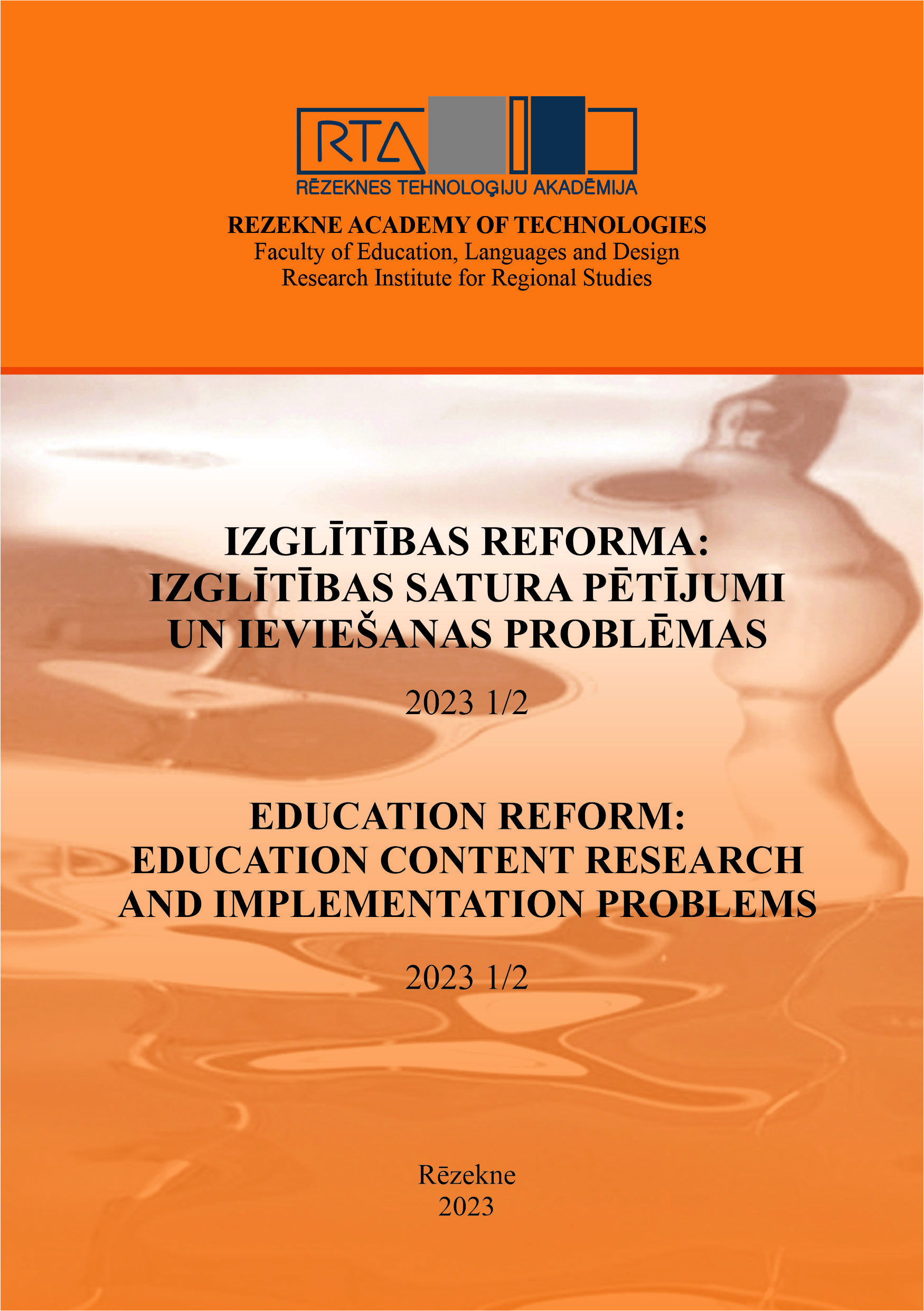DEVELOPMENT OF CREATIVITY FOR CHILDREN AGE 6-7
DOI:
https://doi.org/10.17770/er2023.1.7338Keywords:
creativity, nature of creativity, factors affecting creativity, development of creativity, 6-7 year old childrenAbstract
Creativity is the ability to generate new ideas. Creativity is of great importance nowadays, because this skill is in demand in society. It is useful for preschool and school-aged children, when performing the tasks assigned by teachers in an educational institution, as well as applying this skill in solving household problems. At a later stage of life, when a person has already started his independent life - in solving everyday problems or in a professional career, where non-traditional solutions are needed. The aim of the article is to theoretically study the factors affecting creativity and analyze the possibilities of creativity development in 6-7 year old children. In the first part of the article studies and analyzed creativity in the theories of scientists and the factors affecting the development of creativity. The second part of the article analyzes and interprets the triangular evaluation data obtained from 2 groups teachers and 8 children's parents, who evaluated creativity development of 10 children. There are many different factors that affect the development of creativity, so the teacher should be creative and competent in order to be able to apply both the right methods and create an environment favorable to the development of creativity.
References
Amabile, T. (2011). Componential theory of creativity. 538-559 Boston, MA: Harvard Business School. Retrieved from https://edisciplinas.usp.br/pluginfile.php/4927777/mod_resource/content/0/TeresaAMabile.pdf
Aminolroaya, S., Yarmohammadian, M. H., & Keshtiaray, N. (2015). Methods of nurturing creativity during preschool term: An integrative study. Retrieved from https://files.eric.ed.gov/fulltext/EJ1094366.pdf
Beļickis, I., (Sast.), Blūma, D., Koķe, T., Markus, D., Skujiņa, V. (vad.), Šalme, A. (2000) Pedagoģijas terminu skaidrojošā vārdnīca. Retrieved from http://www.termnet.lv/Term.aspx?tabindex=1&search=order&indefinition=False&subject=0&allak=False&language=0
Brakovska, V. (2018). Domāšana un radošums. No S. Lazdiņa (red) Latviešu valodas aģentūras (LVA) zinātniski metodisks izdevums “Tagad”, 1, Nr. 11, 22-30. Retrieved from https://www.researchgate.net/publication/344339899_Poseiko_S_2018_Multimodali_teksti_latviesu_valodas_apguve_zinasanam_prasmem_un_priekam_Multimodal_texts_in_Latvian_Language_Learning_Developing_Knowledge_Skills_Emotions_Lazdina_S_ed_Tagad_1_100_-_113#page=22_113/links/5f6a0303458515b7cf46c67b/Poseiko-S-2018-Multimodali-teksti-latviesu-valodas-apguve-zinasanam-prasmem-un-priekam-Multimodal-texts-in-Latvian-Language-Learning-Developin
Briška, I. & Kalēja-Gasparoviča, D. (2020). Skolēna radošuma sekmēšana un vērtēšana. Skolotāju izglītības joma: Vizuālās mākslas metodika pirmsskolā; vizuālās mākslas metodika sākumizglītībā. Rīga: LU Akadēmiskais apgāds. Retrieved from https://dspace.lu.lv/dspace/bitstream/handle/7/54426/skolena_radosuma_sekmesana_un_vertesana.pdf?sequence=1&isAllowed=y
Deiviss, G. A. (1982). A model for teaching for creative development. Roeper Review, 5(2), 27–29. DOI: https://doi.org/10.1080/02783198209552674
Fasko, D. (2001). Education and creativity. Creativity research journal, 13(3-4), 317-327. Retrieved from: https://citeseerx.ist.psu.edu/document?repid=rep1&type=pdf&doi=a43374cdea4029f7eae03e682bab683558872bd7
Graue, E., Whyte, K., & Karabon, A. E. (2015). The power of improvisational teaching. Teacher Education Faculty Publications, 96. Retrieved from https://core.ac.uk/download/pdf/232763725.pdf
Hammerton, G. & Munafò, M.R. (2021). Causal inference with observational data: the need for triangulation of evidence. Psychological Medicine 51, 563–578. DOI: https://doi.org/10.1017/S0033291720005127
MK Nr. 480 (2016). Izglītojamo audzināšanas vadlīnijas un informācijas, mācību līdzekļu, materiālu un mācību un audzināšanas metožu izvērtēšanas kārtība. Retrieved from https://likumi.lv/ta/id/283735-izglitojamo-audzinasanas-vadlinijas-un-informacijas-macibu-lidzeklu-materialu-un-macibu-un-audzinasanas-metozu-izvertesanas
Nevanen, S., Juvonen, A., & Ruismäki, H. (2014). Kindergarten and school as a learning environment for art. International Journal of Education Through Art, 10(1), 7-22. DOI: https://doi.org/10.1386/eta.10.1.7_1
Smilga, S. (2017). Kreativitāti attīstoši uzdevumi otrās svešvalodas apguvē studiju procesā. XVIII Turiba University conference communication in the global village: interests and influence, 181-191. Retrieved from https://www.turiba.lv/storage/files/conference-xviii-turiba18052017final.pdf#page=182
Sternberg, R. J. & Williams, W. M. (1996). How to Develop Student Creativity. Retrieved from https://books.google.lv/books?hl=lv&lr=&id=KkLREMn3alsC&oi=fnd&pg=PA1&dq=Develop+Student+Creativity,+by+R.+J.+Sternberg+%26+W.+M.+Williams,+1996,+Alexandria,+&ots=fsEGYGa4J6&sig=5WG0j3Nv2V6cPDz98n36s2iB3To&redir_esc=y#v=onepage&q&f=false
Šūmane, I. (2012). Pusaudžu mācību sasniegumus veicinoša mācību vide. Retrieved from http://dspace.lu.lv/dspace/bitstream/handle/7/4671/20543-Ilze_Sumane_2012.pdf?sequence=1&isAllowed=y
Zdanevych, L., Buchkivska, V., Greskova, B., Аndriievskyi, A, & Perminova, L. (2020). Creativity formation in the context of social and psychological adaptation of preschoolers aged 5-6 Years. International Journal of Cognitive Research in Science, Engineering and Education, 8, 79-91. Retrieved from https://cyberleninka.ru/article/n/creativity-formation-in-the-context-of-social-and-psychological-adaptation-of-preschoolers-aged-5-6-years
Walia, C. (2019). A dynamic definition of creativity. Creativity Research Journal, 31(3), 237-247. DOI: https://doi.org/10.1080/10400419.2019.1641787






